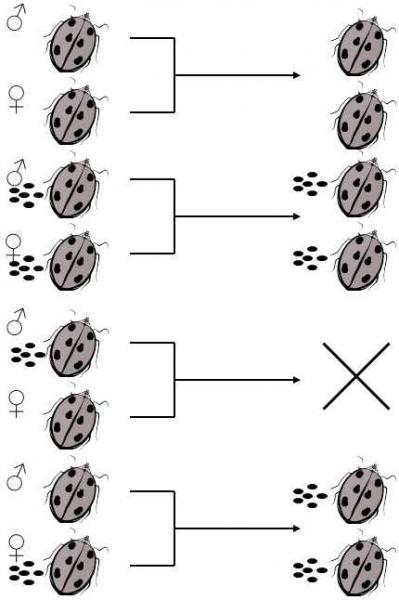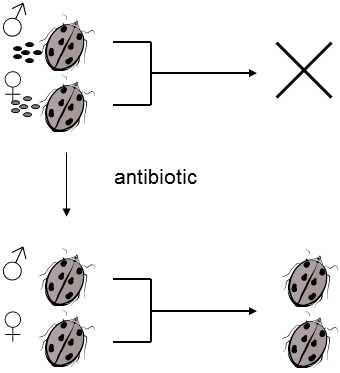XXI.5.4 Reproductive barriers causing speciation can also build up as a result of the activity of some parasitic microorganisms
Postzygotic reproductive isolation barriers can be a direct product of the activity of some parasitic microorganisms (Breeuwer & Werren 1995). The best known and apparently the most widely spread such parasites are bacteria of the Wolbachia genus, which parasitize in the cells of a large number of species of arthropods, especially insects, and in nematodes. It has been estimated that up to 75% of all species of arthropods are infected by them (Stevens, Giordano, & Fialho 2002). One of the many manifestations of the presence of parasites is the formation of reproductive incompatibility between infected males and uninfected females of the host species. Wolbachia cannot be transmitted by male sex cells. Thus, if this parasite finds itself in the body of a male, it has only a very few ways of increasing its inclusive fitness. One of these is induction of reproductive incompatibility between infected males and uninfected females. If an infected male copulates with both infected and uninfected females, only the infected ones produce viable (and infected) progeny and their percentage in the population and thus also the total number of parasites (potential relatives of the parasite that induced the reproductive incompatibility in the male) will increase (Fig. XXI.13).

Fig. XXI.13 Wolbachia and cytoplasmatic incompatibility. Wolbachia can be transferred to progeny only through female gametes. If Wolbachia are present in the body of a male, one of the few ways in which they can increase their inclusive fitness consists in allowing the males to reproduce only with females that are also infected by Wolbachia. As uninfected females can fertilely reproduce only with uninfected males, they have lower fitness than infected females and their fraction gradually decreases in the population.
The mechanism of induction of incompatibility is not known in detail. It was originally supposed that the sperm of infected males contain a toxin that, after fertilization, destroys the zygote formed from eggs that do not contain the antitoxin formed by Wolbachia in infected females. The new results, however, suggest that Wolbachia changes the timing of certain steps in the division of the male cell nucleus, which may lead to desynchronization of divisions of pronuclei of male and female origin in a fertilized ovum and therefore disruption of division of the zygote {10891}.
Various strains or various species of Wolbachia frequently exist in the host population and their toxins and antitoxins (or their desynchronization mechanisms) need not be compatible. Thus, if one Wolbachia variant spreads in part of the population and a different one in another part of the population, the incompatibility of their toxins and antitoxins may lead to an impermeable reproductive barrier between the two subpopulations and can facilitate speciation. The fact that Wolbachia is really responsible for the existence of reproduction barriers can be verified by “curing” the relevant host species by administration of antibiotics (Fig. XXI.14).

Fig. XXI.14 Reproduction barrier as a consequence of bilateral cytoplasmic incompatibility. If two strains of Wolbachia, differing, for example, in the toxin responsible for cytoplasmatic incompatibility, spread simultaneously in the population, the original host species can divide into two mutually reproductively isolated species. Individuals infected by different Wolbachia strains cannot fertilely cross and cannot even be mutually infected by a different Wolbachia strain. If we eliminate infection of the host species by using antibiotics, the ability to cross is generally renewed and the two species merge again to form a single species
Following this procedure, the mutual reproductive incompatibility of the members of the two populations generally disappears (Mandel, Ross, & Harrison 2001). According to some theories, Wolbachia are the main motor for speciation in insects and also the reason why a great many of its taxa are extremely rich in species (Rokas 2000).
